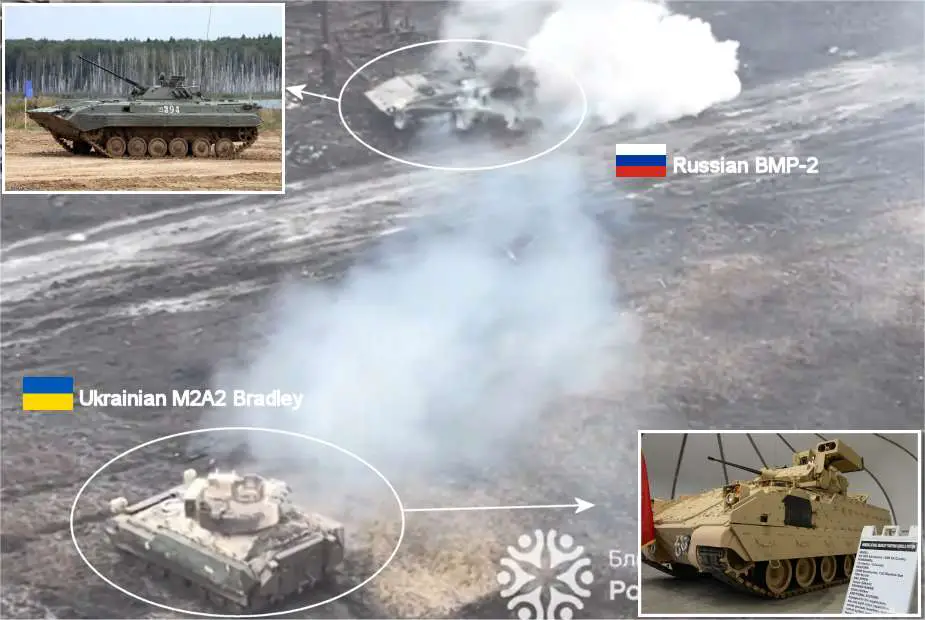A Ukrainian Infantry Fighting Vehicle (IFV) M2A2 ODS-SA "Bradley" engaged in rare close combat with a Russian BMP-2 IFV near Avdiivka. This intense encounter was vividly captured by a Ukrainian drone and posted on social media by the Ukrainian Front dated March 6, 2024. Utilizing its M242 Bushmaster automatic cannon, the Bradley fired a series of shells at its Russian counterpart leading to its destruction. However, it is noted that the BMP-2 did not appear to be moving, and there are doubts about the presence of a crew inside the vehicle.
Follow Army Recognition on Google News at this link

Rare close combat footage of a Russian BMP-2 and a Ukrainian Bradley M2A2. (Picture source: Social Media / US DoD / Vitaly V. Kuzmin )
The BMP-2 and M2A2 ODS-SA are two IFVs that offer contrasting approaches to armored warfare, reflecting the military doctrines and technological advancements of their respective home countries.
This combat highlights the crucial technological and operational differences between the M2A2 Bradley and the BMP-2, vehicles that embody the contrasting military doctrines of the West and East from the Cold War era. The M2A2 Bradley, with its reinforced armor, offers improved protection against enemy fire, making it more resilient, especially against artillery shells and small-caliber munitions. Its armament includes a 25 mm Bushmaster M242 automatic cannon capable of firing various types of ammunition, and it is also equipped with TOW missiles for long-range anti-tank engagements. In contrast, the BMP-2, designed for agility and speed, is armed with a 30 mm automatic cannon and anti-tank missiles, but its lighter armor makes it more vulnerable to direct impacts.
Designed in Russia, the BMP-2 is a lighter vehicle at 14,300 kg, aiming to provide mobility and flexibility on the battlefield. It is armed with a 30mm 2A42 cannon, a coaxial PKT 7.62mm machine gun, and an anti-tank guided missile system capable of firing AT-5 Spandrel or AT-4 Spigot missiles. Its armor is designed to protect against small arms fire and shrapnel, with a front capable of resisting 23mm armor-piercing rounds and 7.62-mm armor-piercing bullets for the sides. The BMP-2 can carry a crew of 3, plus 7 additional soldiers, reaching a maximum road speed of 65 km/h and a range of 550 to 600 km. It is equipped with infrared night vision, an NBC (nuclear, biological, chemical) protection system, and a fire control system.
On the other hand, the M2A2 ODS-SA, developed by the United States, is significantly heavier at 27,000 kg, reflecting its focus on protection and firepower. Ukraine has received about 190 M2A2 ODS-SA Bradley IFVs from the United States, a variant developed based on combat experience in Iraq during Operation Desert Storm with significant improvements. It is equipped with a 25mm M242 cannon, a coaxial 7.62mm M240C machine gun, two TOW missile launchers, and two sets of four smoke grenade launchers. The vehicle's spaced laminated armor offers comprehensive protection against RPGs 30mm APDS rounds, and 155mm shell fragments. This IFV can carry a crew of 3 and up to 6 soldiers, with a maximum speed of 56 km/h and a range of 400 km. It also includes an NBC protection system, thermal night vision, and automatic fire extinguishers.
The M2A2 ODS-SA prioritizes survival and lethality, with its heavier armor and advanced weapon systems offering comprehensive protection and a diverse range of offensive capabilities. In contrast, the BMP-2 emphasizes speed, agility, and the ability to rapidly deploy troops under the cover of its armament. This makes the BMP-2 more suited to rapid maneuver warfare, while the M2A2 ODS-SA is better equipped for sustained engagements where its superior protection and firepower can be fully utilized.
These differences reflect the strategic priorities of their respective countries. The United States, with the M2A2 ODS-SA, focuses on protecting forces and technological superiority to enhance the survival of their troops in a variety of combat scenarios. Russia's BMP-2, with its combination of mobility, firepower, and ability to rapidly deploy infantry, is designed to exploit the fluidity of the modern battlefield, allowing for rapid advances and flexible responses to changing tactical situations.
In summary, the BMP-2 and M2A2 ODS-SA are both highly capable IFVs, suited to their specific military philosophies and operational requirements, offering unique advantages in terms of protection, mobility, and firepower. However, in this combat and others, the Bradley M2A2 seems to have the upper hand over its Russian counterpart, marking not the first time a battle between these two vehicles has favored American material. However, it is unclear whether the BMP-2 was manned or not, making this a case to follow.
















